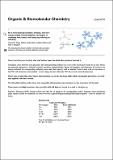| dc.contributor.author | Wang, Guan-Nan | |
| dc.contributor.author | Murphy, Paul V. | |
| dc.date.accessioned | 2014-04-08T11:41:35Z | |
| dc.date.available | 2014-04-08T11:41:35Z | |
| dc.date.issued | 2012-06-29 | |
| dc.identifier.citation | Wang, G.-N., Andre, S., Gabius, H.-J., & Murphy, P. V. Bi- to tetravalent glycoclusters: synthesis, structure-activity profiles as lectin inhibitors and impact of combining both valency and headgroup tailoring on selectivity. Organic & Biomolecular Chemistry, 10(34), 6893-6907. | en_US |
| dc.identifier.issn | 1477-0520 | |
| dc.identifier.uri | http://hdl.handle.net/10379/4279 | |
| dc.description | Journal article | en_US |
| dc.description.abstract | The emerging functional versatility of cellular glycans makes research on the design of synthetic inhibitors a timely topic. In detail, the combination of ligand (or headgroup or contact site) structure with spatial parameters that depend on topological and geometrical factors underlies the physiological selectivity of glycan-protein (lectin) recognition. We herein tested a panel of bi-, tri- and tetravalent compounds against two plant agglutinins and adhesion/growth-regulatory lectins (galectins). In addition, we examined the impact of headgroup tailoring (converting lactose to 2'-fucosyllactose) in combination with valency increase in two assay types of increasing biorelevance (from solid-phase binding to cell binding). Compounds were prepared using copper-catalysed azide alkyne cycloaddition from peracetylated lactosyl or 2'-fucosyllactosyl azides. Significant inhibition was achieved for the plant toxin with a tetravalent compound. Different levels of sensitivity were noted for the three groups of the galectin family. The headgroup extension to 2'-fucosyllactose led to a selectivity gain, especially for the chimera-type galectin-3. Valency increase established discrimination against the homodimeric proteins, whereas the combination of valency with the headgroup extension led to discrimination against the tandem-repeat-type galectin-8 for chicken galectins but not human galectins-3 and -4. Thus, detailed structure-activity profiling of glycoclusters combined with suitably modifying the contact site for the targeted lectin will help minimize cross-reactivity among this class of closely related proteins. | en_US |
| dc.description.sponsorship | GlycHIT (contract ID 260600); Verein zur Förder-ung des biologisch-technologischen Fortschritts in der Medizine; Science Foundation Ireland (08/SRC/B1393). | en_US |
| dc.format | application/pdf | en_US |
| dc.language.iso | en | en_US |
| dc.publisher | Royal Society of Chemistry | en_US |
| dc.relation.ispartof | Organic & Biomolecular Chemistry | en |
| dc.rights | Attribution-NonCommercial-NoDerivs 3.0 Ireland | |
| dc.rights.uri | https://creativecommons.org/licenses/by-nc-nd/3.0/ie/ | |
| dc.subject | Cellular glycans | en_US |
| dc.subject | Lectin | en_US |
| dc.title | Bi- to tetravalent glycoclusters: synthesis, structure-activity profiles as lectin inhibitors and impact of combining both valency and headgroup tailoring on selectivity. | en_US |
| dc.type | Article | en_US |
| dc.date.updated | 2014-04-04T11:50:24Z | |
| dc.identifier.doi | 10.1039/c2ob25870f | |
| dc.local.publishedsource | http://dx.doi.org/10.1039/C2OB25870F | en_US |
| dc.description.peer-reviewed | peer-reviewed | |
| dc.contributor.funder | |~| | |
| dc.internal.rssid | 5950709 | |
| dc.local.contact | Paul Murphy, School Of Chemistry, Room 236, Arts/Science Building, Nui Galway. 2465 Email: paul.v.murphy@nuigalway.ie | |
| dc.local.copyrightchecked | No Proof attached | |
| dc.local.version | ACCEPTED | |
| nui.item.downloads | 420 | |


